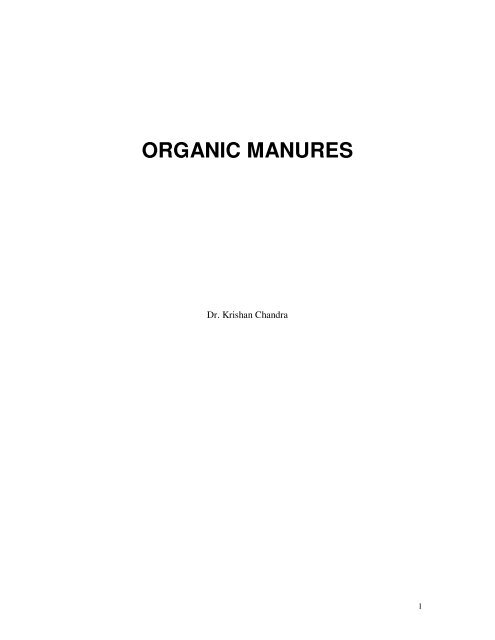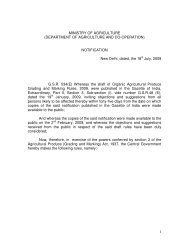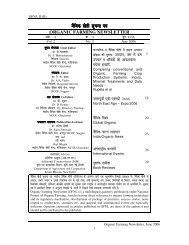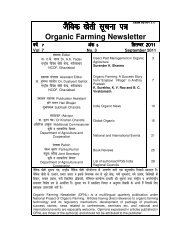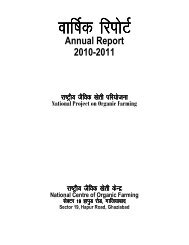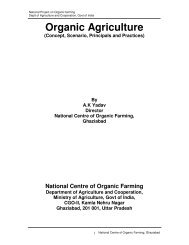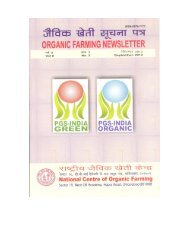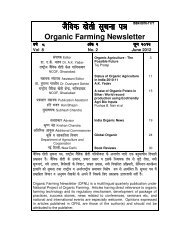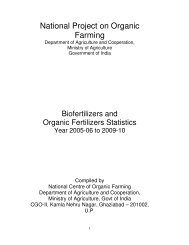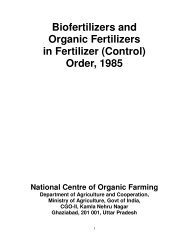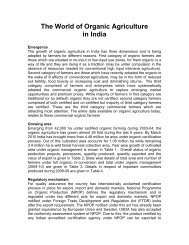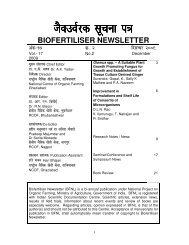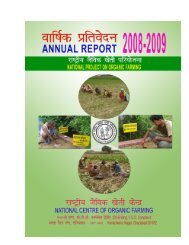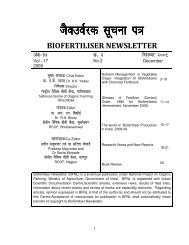ORGANIC MANURES - National Centre of Organic Farming
ORGANIC MANURES - National Centre of Organic Farming
ORGANIC MANURES - National Centre of Organic Farming
Create successful ePaper yourself
Turn your PDF publications into a flip-book with our unique Google optimized e-Paper software.
<strong>ORGANIC</strong> <strong>MANURES</strong>Dr. Krishan Chandra1
PREFACEThere is an increasing awareness about organic agricultural practices in the world.But, Indian farmers yet to be realize about ill effect <strong>of</strong> modern agriculture. Hencealternative farming particularly <strong>Organic</strong> <strong>Farming</strong> is hour <strong>of</strong> the need to get rid <strong>of</strong>chemical fertilizers, pesticides and growth regulators etc. To promote organic farming inIndia, Ministry <strong>of</strong> Agriculture, Govt. <strong>of</strong> India has launched a <strong>National</strong> Project on <strong>Organic</strong><strong>Farming</strong>, during Ist October, 2004. Under the <strong>National</strong> Programme, TrainingProgrammes for different level <strong>of</strong>ficials, farmers and input producers beingimplemented, while educating the people there is demand <strong>of</strong> books based on practicalexperience in relevant titles. So authors were attempted to collect the practicalinformation and disseminate the details in the form <strong>of</strong> booklet on organic manures . Wehope, this booklet will fulfill the practical as well as theoretical information aboutdifferent organic manures as well as availability in South India. We hope this manualwould be useful to trainees as well as farmers who are involved in promotion <strong>of</strong> organicfarming or willing to convert their lands to organic cultivation.Krishan Chandra2
Published by :Regional DirectorRegional <strong>Centre</strong> <strong>of</strong> <strong>Organic</strong> <strong>Farming</strong>No. 34, 5 th Main RoadHebbal, Banglaore-24Year <strong>of</strong> Publication – January 2005Released on the occasion <strong>of</strong> 10 days training programme on“Production and Quality Control <strong>of</strong> <strong>Organic</strong> Inputs”Kottayam, Kerala3
I INTRODUCTIONThe crop removes large quantity <strong>of</strong> plant nutrients from soil, particularlythe removal <strong>of</strong> NPK nutrients at the present level <strong>of</strong> crop production has beenestimated at 125 kg/ha/annum whereas the annual addition is not more than 75kg resulting in depletion <strong>of</strong> the nutrient reserve <strong>of</strong> soil. The excessive reliance onchemical fertilizers and the negligence shown to the conservation and use <strong>of</strong>organic sources <strong>of</strong> nutrients have not only caused the exhaustion <strong>of</strong> soil <strong>of</strong> itsnutrient reserves but also resulted in soil health problems not conducive toachieving consistent increase in agricultural production. Moreover, Indian soilsare poor in organic matter and in major plant nutrients. Soil organic matter is thekey to soil fertility and productivity. In the absence <strong>of</strong> organic matter, the soil is amixture <strong>of</strong> sand, silt and clay. <strong>Organic</strong> matter induces life into this inert mixtureand promotes biological activities. Although the beneficial influence <strong>of</strong> organicmatter on the physical, chemical and biological properties <strong>of</strong> the soil is widelyknown, the full appreciation <strong>of</strong> the same remains largely ignored in modernagriculture.The regular recycling <strong>of</strong> organic wastes in the soil is the most efficientmethod <strong>of</strong> maintaining optimum levels <strong>of</strong> soil organic matter. Recycling <strong>of</strong> organicmatter in the soil should become a regular feature <strong>of</strong> modern agriculture. In thetraditional agriculture, followed over generations in India, the use <strong>of</strong> plant andanimal wastes as a source <strong>of</strong> plant nutrient was the accepted practice. Theimportance and aim <strong>of</strong> organic manures and green manure crops have failed tobe recognized in modern agriculture. The average absorption <strong>of</strong> micronutrientsby some crops given in Table –1.Table – 1 Average absorption <strong>of</strong> micronutrients by some cropsCropEconomicYield t/ha*Total uptake , gramsZn Fe Mn Cu B MoRice 1.0 40 153 675 18 15 2Wheat 1.0 56 624 70 24 48 2Maize 1.0 130 1200 320 130 - -Sorghum 1.0 72 720 54 6 54 2Pearl millet 1.0 40 170 20 8 - -Cassava 1.0 45 120 45 5 15 -Potato 1.0 9 160 12 12 50 0.3Chickpea 1.5 57 1302 105 17 - -Pigeonpea 1.2 38 1440 128 31 - -Soybean 2.5 192 866 208 74 - -Groundnut 1.9 208 4340 176 68 - -Mustard 1.5 150 1684 143 25 - -Sunflower 0.6 28 645 109 23 - -Sesamum 1.2 202 952 138 140 - -4
Linseed 1.6 73 1062 283 48 - -Jute 1.0 214 784 251 27 - -C<strong>of</strong>fee 1.0 35 83 62 82 - -Tea 1.0 276 2007 1933 632 101 -Guinea grass 269 558 2940 1880 443 - -Berseem 112 980 650 580 95 - -Alfalfa 107 433 710 620 75 - -Notes: Data for crops 1-7 are on per tonne yield basis: rest for indicated yieldlevels.EFFECT OF IN<strong>ORGANIC</strong> FERTILIZERS AND OTHER AGRO-CHEMICALS ONSOIL AND PLANTSExcessive use <strong>of</strong> chemical fertilizers and other agro chemicals, which are theimportant inputs in modern farming creates depletion in soil fertility and pollutionin surface water bodies.1. Water soluble fertilizers when applied to soil, a good portion <strong>of</strong> the addednutrients does not become available to the crop plants and lost either tothe atmosphere up to the hydrosphere due to non stimulation <strong>of</strong> theactivities <strong>of</strong> heterotrophic soil organisms but facilitate that <strong>of</strong> theautotrophic nitrifying organisms, thereby hindering the immobilization <strong>of</strong>nutrients.2. As a matter <strong>of</strong> fact, it results in rapid rate <strong>of</strong> nutrients loss in different formsand increases the soil acidity with nitrification.3. Emission <strong>of</strong> ammonia, methane, nitrous oxide and elemental nitrogen fromthe soil system as a result <strong>of</strong> denitrification.4. Depletion <strong>of</strong> secondary and micronutrients especially Sulphur and Zinc.5. Deficiency <strong>of</strong> these nutrients (S & Zn) along with that <strong>of</strong> Mg, Mn, Fe, Mo, Band Cu limits productivity <strong>of</strong> many field crops especially in rice.6. Dhar (1962) cautioned that by adding large doses <strong>of</strong> N-fertilizers inmodern agriculture without the use <strong>of</strong> organic manures, there is alwaysthe danger <strong>of</strong> humus depletion and fall in crop production, which can beavoided only by adding additional amounts <strong>of</strong> organic residues andmanures.7. When high levels <strong>of</strong> N-fertilizers especially nitrate forms are applied to soil,nitrate pollution <strong>of</strong> drinking water is a serious health hazard found inextensively irrigated coarse textured highly percolating soils <strong>of</strong> centralPunjab, where 40-50% <strong>of</strong> applied nitrogen is lost in leaching and the meanconcentrations <strong>of</strong> nitrate nitrogen was 3.88 ppm during 1982 (Rainyseason) ans 1.02 ppm in 1975. In 10% <strong>of</strong> the ground water samplesnitrate concentration was 10 ppm which was the upper tolerance limit indrinking water against nil in 1975 (Singh et al, 1987).5
8. Alarming issue to human health is regular use <strong>of</strong> phosphatic fertilizer inlarge quantities <strong>of</strong>ten causes the build up <strong>of</strong> trace metal contaminationsuch as arsenic, fluoride, cadmium etc. in soil and plants. Cadmium insingle super phosphate is available to plants as the Cd in cadmiumchloride. Similarly, chloride contained in MOP and NH 4 Cl creates toxicityto many crops like beans, citrus, grapes lettuce, potatoes etc. These tracemetal toxic contaminants reach the human body, through food chain andcause health problems.9. The water soluble nutrients when carried to lakes and stream throughleaching and surface run <strong>of</strong>f cause eutrophication as manifested by theluxurient growth <strong>of</strong> algae and other water weeds on the water surfaceleading to oxygen deficient condition. This situation is not conducive tohealthy aquatic life.ADVANTAGES OF <strong>ORGANIC</strong> <strong>MANURES</strong>1. <strong>Organic</strong> manure provides all the nutrients that are required by plants but inlimited quantities.2. It helps in maintaining C:N ratio in the soil and also increases the fertilityand productivity <strong>of</strong> the soil.3. It improves the physical, chemical and biological properties <strong>of</strong> the soil.4. It improves both the structure and texture <strong>of</strong> the soils.5. It increases the water holding capacity <strong>of</strong> the soil.6. Due to increase in the biological activity, the nutrients that are in the lowerdepths are made available to the plants.7. It acts as much, thereby minimizing the evaporation losses <strong>of</strong> moisture.from the soil.MAJOR <strong>ORGANIC</strong> SOURCES AND TRANSFORMATIONSCarbon present in soil is in the form <strong>of</strong> organic matter. The organicmaterials most commonly used to improve soil conditions and fertility includefarm yard manure (FYM), animal wastes, crop residues, urban organic wastes(either as such or composted), green manures, bio-gas spent slurry, microbialpreparations, vermicompost and biodynamic preparations. Sewage sludge andsome <strong>of</strong> the industrial wastes also find application in agriculture.For all organic matter, atmospheric carbon dioxide serves as the mainsource <strong>of</strong> carbon. Carbon dioxide is converted to organic carbon largely by theaction <strong>of</strong> photoautotrophic organisms; the higher green plants on land and algaein aquatic habitats. Carbon is being contentiously fixed into organic form throughthe process <strong>of</strong> photosynthesis and once bound; the carbon becomes unavailablefor use in the generation <strong>of</strong> new plant life. Carbon fixation involves a reduction <strong>of</strong>carbon dioxide by hydrogen donor NADPH (reduced form <strong>of</strong> the co-enzymenicotinamide adenine dinucleotide phosphate, NADP) and the synthesis <strong>of</strong>carbohydrate from reduced carbon through complex cyclic mechanism called the6
Calvin cycle. Carbon dioxide constitutes only 0.03 percent by volume <strong>of</strong> theearths atmosphere. It has been estimated that the vegetation <strong>of</strong> the earth'ssurface consumes some 90 billion kg carbon dioxide per annum, about onetwenty - fifth <strong>of</strong> the total supply <strong>of</strong> the atmosphere and that the total supply <strong>of</strong>carbon dioxide would be completely exhausted in twenty years at the presentrate <strong>of</strong> photosynthesis , if not replenished by decomposition <strong>of</strong> organic materials.As the availability <strong>of</strong> carbon dioxide on the earth's surface is very limited, it mustbe recycled. Upon the death <strong>of</strong> the plants and animals, microbiologicalmetabolism assumes the dominant role in cyclic sequence. The dead tissuesadded to soil undergo decay and are transformed into microbial cells and a vastheterogeneous body <strong>of</strong> carbonaceous compounds. According to the differentstages <strong>of</strong> decomposition, the soil organic matter becomes available in distinctfractions. Farm yard manure made from cattle dung, excreta <strong>of</strong> other animals,animal tissues and excretory products, and compost from rural and urbanwastes, crop residues and green-manure are collectively designated as bulkyorganic manures because <strong>of</strong> their low contents <strong>of</strong> major nutrients, while materialslike oil cakes, fish meal, animal meal, poultry manures, slaughter house wastescontaining comparatively higher contents <strong>of</strong> plant nutrients are grouped underconcentrated organic manures. In general organic manures containing upto twopercent nitrogen are included in bulky category and those with more than twopercent nitrogen are treated as concentrated. Irrespective <strong>of</strong> source andcomposition, organic matter when added into the soil undergoes microbial decayand becomes the food for micro flora and fauna. Even the microbial cells serveas a source <strong>of</strong> carbon for succeeding generations <strong>of</strong> microscopic populations. Agreat variety <strong>of</strong> microorganisms live in soil which include bacteria, actinomycetes,fungi, algae and protozoa. In general the number per gram <strong>of</strong> soil is bacteria >actinomycetes > fungi > algae > protozoa. The average nutrient content <strong>of</strong> bulkymanures given in table –3Table - 2 Average nutrient content <strong>of</strong> bulky manureManurePercentage contentN P 2 O5 K 2 OAnimal refuse 0.3-0.4 0.1-0.2 0.1-0.3Cattle dung,fresh 0.4-0.5 0.3-0.4 0.3-0.4Horse dung ,fresh 0.5 -0.5 0.4-0.6 0.3-1.0Poultry manure,fresh 1.0-1.8 1.4-1.8 0.8-0.9Sewage sludge,dry 2.0-3.5 1.0-5.0 0.2-0.5Sewage sludge, activate dry 4.0-7.0 2.1-4.2 0.5-0.7Cattle urine 0.9-1.2 trace 0.5-1.0Horse urine 1.2-1.5 trace 1.3-1.5Human urine 0.6-1.0 0.1-0.2 0.2-0.3Sheep urine 1.5-1.7 trace 1.8-2.0Ash, coal 0.73 0.45 0.537
Ash,household 0.5-1.9 1.6-4.2 2.3-12.0Ash,wood 0.1-0.2 0.8-5.9 1.5-36.0Rural compost,dry 0.5-1.0 0.4-0.8 0.8-1.2Urban compost,dry 0.7-2.0 0.9-3.0 1.0-2.0Farmyard manure,dry 0.4-1.5 0.3-0.9 0.3-1.9Filter-press cake 1.0-1.5 4.0-5.0 2.0-7.0Rice hulls 0.3-0.5 0.2-0.5 0.3-0.5Groundnut husks 1.6-1.8 0.3-0.5 1.1-1.7Banana,dry 0.61 0.12 1.00Cotton 0.44 0.10 0.66Source:<strong>Organic</strong> <strong>Farming</strong> for Sustainable Agriculture by A.K.Dhama ,1996 AgroBenificial Publishers (India)CHEMICAL NATURE OF <strong>ORGANIC</strong> MATTER AND ITS DECOMPOSTION<strong>Organic</strong> matter is a complex mixture <strong>of</strong> many chemical substances. Thesematerials serve as precursors <strong>of</strong> soil humus. The most commonly found and wellunderstood organic compounds finding their way into the soil and are subjectedto normal decomposition processes are : 1. carbohydrates (sugars, starches,hemicelluloses, cellulose, pectins, gums, mucilages, etc.;), 2 proteins, aminoacids,amins, etc.; 3. fats oil, waxes, resins, etc; 4 alcohol, aldehydes, Ketones,etc; 5 organic acid; 6 lignin; 7. compounds having ring structures (phenols,tannins, hydrocarbons), 8. alkaloids and compounds with organic bases --pyridine and purine, and 9 miscellaneous substances -- antibiotics, auxins,vitamins, enzymes and pigments. The inorganic constituents, usually present inash containing major and minor elements amounting 12-15 percent byweight.The chemical composition <strong>of</strong> organic mater given in table 4Table 4 Chemical composition <strong>of</strong> organic matterFractions% (dry weight basis)Sugars, starches, amino acids, urea, 2-30Ammonium salts (hot/cold water solubles)Fats, oils, waxes, (ether / alcohol solubles) 1-158
Proteins 5-40Hemicelluloses 10-30Cellulose 15-60Lignin 5-30Mineral matter (ash) 5-30Source: FAO Soil Bulletin (1987)56<strong>Organic</strong> matter while entering into the soil, undergoes decay and finallygets converted into carbon dioxide, water, nitrogen, sulphur oxide and keepsreplenishing naturally the carbon, nitrogen and sulphur cycles. On ageing, thewater soluble constituents <strong>of</strong> the plant tissues like proteins and mineralsdecrease and the percentage abundance <strong>of</strong> cellulose, hemi cellulose and ligninrises. Compounds with linear chain structure are easily decomposed comparedto those with cyclic (or) ring structures. Lignin is more resistant to microbialattack., the order <strong>of</strong> easy decomposition is protein > cellulose > fats, waxes >lignin. Nearly all biological transformations that occur in soil are mediated bymicrobial activity. This means all the factors that influence microorganisms areimportant in the transformation <strong>of</strong> dead plant materials. The most importantfactors are temperature, soil moisture, rate <strong>of</strong> gas exchange, easy availability <strong>of</strong>nutrients and structure <strong>of</strong> the colloidal minerals materials. The age <strong>of</strong> the plantresidues, it's lignin content, and the degree <strong>of</strong> disintegration <strong>of</strong> substrata alsogovern the rate <strong>of</strong> decomposition.Microorganisms decompose the organic materials to obtain energy forgrowth and carbon for the synthesis <strong>of</strong> new cell material Carbon dioxide,methane, organic acids, alcohol and other oxidized and partly oxidized form <strong>of</strong>carbon may be metabolic wastes for one group <strong>of</strong> microorganisms. whereas theymay serve as energy and carbon source for other group. To decompose complexcompounds, microorganism are required to liberate more number <strong>of</strong> enzymes.Single organic compound like cytoplasm <strong>of</strong> blue green algae are decomposedreadily in two and half days by 50 percent while corn stalk required two and halfmonths.Generally, if fresh organic matter with a carbon : nitrogen ratio (proportion<strong>of</strong> percentage <strong>of</strong> carbon to that <strong>of</strong> nitrogen) <strong>of</strong> greater than 30 is added to a soil,there is immobilization <strong>of</strong> nitrogen during the initial decomposition process. Forratios between 20 and 30, the mineralization and immobilization may be equal.Release <strong>of</strong> mineral nitrogen early in the process is caused when organic matterwith a carbon : nitrogen ratio <strong>of</strong> less than 20 decomposes. The carbon : nitrogenratio <strong>of</strong> stabilised humus is considered to be 10 : 1. This critical ratio is areflection <strong>of</strong> the dynamic equilibrium that results from the dominating microbialpopulation. The microbial protoplasm contains approximately carbon : nitrogenratios <strong>of</strong> 5 : 1, 10 : 1 and 15 : 1 for bacteria, fungi and actinomycetesrespectively (Hattori, 1973). Immobilization is a temporary locking up <strong>of</strong> theavailable plant nutrients.Under both natural and agricultural conditions, an equilibrium isestablished between the humus being synthesized from fresh additions <strong>of</strong>organic materials and the native humus already present in soil. Under normal9
conditions the mineralization <strong>of</strong> native humus is compensated by synthesis <strong>of</strong>new humus.HUMIFICATION AND RESIDUAL EFFECTAll organic residues incorporated into the soil undergo decomposition fromthe original residues, a series <strong>of</strong> products are formed. As the original materialand the initial products undergo further decomposition, they become a brownblack organic complex known by the name humus.Humus remain in dynamic yet fairly stable state. It is under continualattack by soil microorganisms. Decomposition and synthesis by microbialprocesses occur simultaneously, the rate depending on the nature andabundance <strong>of</strong> microorganisms involved, the moisture content, temperature, pH,aeration, quantity <strong>of</strong> freshly added organic matter and the extent <strong>of</strong> availability <strong>of</strong>carbon, nitrogen, phosphorus and potassium. Chemically humus has beencharacterized as ligno-protein or ligno-acid complex containing approximately 45percent lignin compounds, 35 percent amino acids, 11 percent carbohydrates (4percent cellulose, 7 percent hemicelluloses) 3 percent fats, waxes and resins and6 percent other miscellaneous substances. (Finch et al., 1971). Martin et al.(1974) have shown that some fungal mycelium and lignin, and lignin likesubstances <strong>of</strong> plant origin are the main building blocks for synthesis <strong>of</strong> humicsubstances. The humus is a finally synthesized stable product in natural oragricultural conditions. During humification the nitrogen compounds react in mostcases as organic amino compounds and to a lesser extent, as ammonia. Somelosses <strong>of</strong> nitrogen occur in gaseous form as nitrogen or nitrous oxide. Sulphur isbound in the orginal organic compounds as sulphide very rarely as sulphate andtransformed in the soil to sulphate, Phosphorus occurs in the organic compoundsas phosphate esters, which are hydrolyzed. Potassium, calcium, magnesium andthe heavy metals present in plant residues as complexes are liberated duringhumification into ions. Very <strong>of</strong>ten they form other complexes with newly formedorganic compounds during humifiction and interact with the soil colloids (salycilicacids, sesquio-oxide and clay) depending on soil properties and environment.Themechanism leading to an increase in the nitrogen content in lignin residue <strong>of</strong>plants has not been clearly explained. It has been clarified to certain extent thatamino acid, protein and amino sugar nitrogen and the products are stabilisedagainst microbial decomposition by their entry during polymerization <strong>of</strong> humicmaterials (Verma et al., 1975). The nitrogenous substances formed in this way,serve as slow release nitrogen source for plant growth and have a residual effectbecause they are only gradually subjected to microbial attack. The isotopiclabeled studies have shown that there is a loss <strong>of</strong> 70, 80 and 90-92 percent <strong>of</strong>incorporated organic matter into soil after 1, 2 and 8 - 10 years respectively.Table 5 shows the list <strong>of</strong> organic manures and their N.P.K . statesTable – 5 List <strong>of</strong> <strong>Organic</strong> Manures10
ManurePercentage contentNitrogen( N)Phosphoric acid (P 2 O5 )Potash(K 2 O)Coir pith 1.20 1.20 1.20Blood meal 10-12 1.2 1.0Press mud 1-1.5 4-5 2-7Bone meal1)Raw bone meal 3-4 20-25 -2)Steamed bone meal 1-2 25-30 -Fish meal 4-10 3.9 0.3-1.5Animal refuse 0.3-0.4 0.1-0.2 0.1-0.3Cattle dung, fresh 0.4-0.5 0.3-0.4 0.3-0.4Horse dung ,fresh 0.5 -0.5 0.4-0.6 0.3-1.0Poultry manure, fresh 1.0-1.8 1.4-1.8 0.8-0.9Sewage sludge, dry 2.0-3.5 1.0-5.0 0.2-0.5Sewage sludge, activate dry 4.0-7.0 2.1-4.2 0.5-0.7Cattle urine 0.9-1.2 trace 0.5-1.0Horse urine 1.2-1.5 trace 1.3-1.5Human urine 0.6-1.0 0.1-0.2 0.2-0.3Sheep urine 1.5-1.7 trace 1.8-2.0Ash, coal 0.73 0.45 0.53Ash, household 0.5-1.9 1.6-4.2 2.3-12.0Ash, wood 0.1-0.2 0.8-5.9 1.5-36.0Rural compost ,dry 0.5-1.0 0.4-0.8 0.8-1.2Urban compost ,dry 0.7-2.0 0.9-3.0 1.0-2.0Farmyard manure ,dry 0.4-1.5 0.3-0.9 0.3-1.9Filter-press cake 1.0-1.5 4.0-5.0 2.0-7.0Rice hulls 0.3-0.5 0.2-0.5 0.3-0.5Groundnut husks 1.6-1.8 0.3-0.5 1.1-1.7Banana, dry 0.61 0.12 1.00Cotton 0.44 0.10 0.66Maize 0.42 1.57 1.65Paddy 0.36 0.08 0.71Tobacco 1.12 0.84 0.80Pigeon pea 1.10 0.58 1.28Wheat 0.53 0.10 1.10Sugarcane trash 0.35 0.10 0.60Tobacco dust 1.10 0.31 0.93Tree leaves, dryCalotropis gigantea 0.35 0.12 0.36Careya arborea 1.67 0.40 2.20Cassia ariculata 0.98 0.12 0.67Dillenia pentagyna 1.34 O.50 3.2011
Madhuca indica 1.66 0.50 2.00Pongamia pinnata 3.69 2.41 2.42Pterocarpus marsupium 1.97 0.40 2.90Terimalia chebula 1.46 0.35 1.35Terminalia paniculata 1.70 0.40 1.60Terminalia tomentosa 1.39 0.40 1.80Xylia dolabriformis 1.37 0.30 1.61Green manures, freshCowpea (vigna unguiculata) 0.71 0.15 0.58Sesbania aculeata 0.62 - -Cluster-beatetragonoloba)(cyamopsis0.34 - -Horse-gram (Dolichos biflorus) 0.33 - -Mothbean 0.80 - -Green gram (vigna radiate) 0.72 0.18 0.53Sunnhemp(Crotalaria juncea) 0.75 0.12 0.51Blackgram(vigna mungo) 0.85 0.18 0.53Non edible Oil CakesCastor cake 4.3 1.8 1.3Cotton cake 3.9 1.8 1.6Karanj cake 3.9 0.9 1.2Mahua cake 2.5 0.8 1.8Neem cake 5.2 1.0 1.4Safflower cake 4.9 1.4 1.2Edible Oil cakesCoconut cake 3.0 1.9 1.8Groundnut cake 7.3 1.51.3Niger cake 4.7 1.8 1.3Rape seed cake 5.2 1.8 1.2Sesame cake 6.2 2.0 1.212
Source: “Hand book <strong>of</strong> Manures and Fertilizers” 1964.GREEN <strong>MANURES</strong>Green manuring can be defined as a practice <strong>of</strong> ploughing or turning intothe soil undecomposed green plant tissues for improving physical structure aswell as soil fertility. Green manuring, wherever feasible, is the principalsupplementary means <strong>of</strong> adding organic matter to the soil. The green-manurecrop supplies organic matter as well as additional nitrogen, particularly if it is alegume crop, due to its ability to fix nitrogen from the air with the help <strong>of</strong> its rootnodule bacteria. The green-manure crops also exercise a protective actionagainst erosion and leaching. Green manure to be incorporated in soil beforeflowering stage because they are grown for their green leafy material, which ishigh in nutrients and protects the soil. Green manures will not break down in tothe soil so quickly, but gradually, add some nutrients to the soil for the next crop.The nutritional potentials and nutritional contents <strong>of</strong> some important greenmanures are given in the Table 5 and 6 respectively.Table 5 : Nutrient potential <strong>of</strong> green manuresGreen manure Biomass (tones) N accumulobase(Kg/ha)Sesbania aculeate 22.50 145.00S. rostrata, 20.06 146.00Crotalaria juncea, 18.40 113.00Tephrosia perpurea 6.80 6.00Green gram 6.50 60.20Black gram 5.12 51.20Cow pea 7.12 63.30Table 6 : Nutrient content <strong>of</strong> important green maturesCropNutrient content (% on dry weight basis)N P KGreen manureSesbania aculeate 3.3 0.7 1.3Crotalaria juncea 2.6 0.6 2.0Sesbania speciosa 2.7 0.5 2.2Tephrosia purpurea 2.4 0.3 0.8Phaseolus trilobus 2.1 0.5 -13
Green leaf manurePongamia glabra 3.2 0.3 1.3Glyricidia maculeata 2.9 0.5 2.8Azadirachta Indica 2.8 0.3 0.4Calatropis gigantecum 2.1 0.7 3.6ADVANTAGES OF GREEN <strong>MANURES</strong>:Usage <strong>of</strong> green leaf manure is advantageous both for crops and soil. Theadvantages are:1. As they decompose rapidly, it is easy to retain the organic matter in thesoil.2. Green manures improve both physical and chemical properties <strong>of</strong> the soil.3. They provide energy to microbes.4. They provide nutrients to the standing crop and also to the next crop.5. Addition <strong>of</strong> green manure crops to the soil, acts as much and prevent soilerosion.6. Leaching <strong>of</strong> nutrients in light soils can be prevented by addition <strong>of</strong> greenmanure.7. Cultivating green manure crops can control weeds.8. Majority <strong>of</strong> green manure crops being legumes, use <strong>of</strong> nitrogenousfertilizers can be minimized.There are different green leaf manure crops that can becultivated and they are:1. COWPEA : Cowpea is one <strong>of</strong> the important leguminous green leaf manurecrops. As this plant is easily decomposable and very well suited for greenmanure purpose. June-July months are best suited for sowing <strong>of</strong> this manure.Even though it is being cultivated in summer months ( March to April). Use <strong>of</strong>effective Rhizobium bacteria increase the fixation <strong>of</strong> nitrogen up to 40 kg/ha.2. DHAINCHA (SESBANIA ACULEATE) : Dhaincha is suitable for loamy andclayey soils. It is fairly resistant to drought as well as stagnation <strong>of</strong> water. It growswell even in alkaline soils and corrects alkalinity if grown repeatedly for 4-5 years.The roots have plenty <strong>of</strong> nodules. It yields about 10-15 tonnes <strong>of</strong> green manureper ha and requires a seed rate <strong>of</strong> 30-40 kg/ha. Use <strong>of</strong> effective Rhizobium strainwith seeds fixes the Nitrogen 1 kg / day.3. SESBANIA SPECIOSA : It is a valuable green manure for wetlands and canbe grown in a wide range <strong>of</strong> soils. Seed production is prolific however, pods arefrequently attacked by insects. This green manure can be raised on the field14
orders. Sesbania seedling (21days) can be planted in a single line at 5-10 cmapart in the borders <strong>of</strong> the fields. In about 90 days it produces about 2-4 tonnes<strong>of</strong> green manure per ha. It does not affect the rice yield by shading or root effect.If second rice crop is planted immediately after the first crop, the manure can beincorporated into the field. About 300-400g <strong>of</strong> seeds are sufficient to raisenursery and plant the seedlings around the boundary <strong>of</strong> one hectare. To controlinsects Verticillium lacanii ( Liquid ) fungi is useful.4. SUNNHEMP (CROTALARIA JUNCEA) : It is a quick growing green manurecrop and gets ready for incorporation in about 45 days after sowing. It does notwithstand heavy irrigation leading to flooding. The crop is at times subject tocomplete damage by leaf eating caterpillars. The crop can produce about 8-12tonnes <strong>of</strong> green biomass per ha. The seed requirement is 30 kg/ha.5. SESBANIA ROSTRATA : One <strong>of</strong> the important features <strong>of</strong> this green manureis that in addition to the root nodules, it produces nodules in the stem. The stemnodulation is an adaptation for waterlogged situation since flooding limits growth<strong>of</strong> green manures and may reduce root nodulation. Under normal condition, bothroot and stem nodules are effective in N fixation. It has higher N content <strong>of</strong> 3.56%on dry weight basis. Biomass production is higher during summer (April – June)than in winter (Dec. – Jan.) season. This green manure can also be produced byraising seedlings (30 days old) and planted in the paddy field along the bunds oras intercrop with rice. Use <strong>of</strong> Rhizobium bacteria increase the nitrogen fixationabout 60-100 kg/ha/year.6. WILD INDIGO (TEPHROSIA PURPUREA) : This is a slow growing greenmanure crop and cattle do not prefer to graze it . The green manure is suitablefor light textured soils, particularly in single crop wetlands. It establishes itself asa self sown crop and the seeds remain viable till the harvest <strong>of</strong> rice. On anaverage about 3-4 tonnes <strong>of</strong> green manure is obtained in one ha. The seed rateis 30 kg/ha. The seeds have a waxy impermeable seed coat and hencescarification is required to induce germination. Soaking seeds in boiling water for2-3 minutes is also equally effective in promoting germination.7. INDIGO (INDIGOFERA TINCTORIA) : It resembles wild indigo and is alongduration crop with more leafy growth. It comes up well in clayey soils with oneor two irrigations.8.PILLIPESARA (PHESEOLUS TRILOBUS) : This is a dual purpose cropyielding good fodder for the cattle and green manure. Pillipesara comes up wellin hot season with sufficient soil moisture. Loamy or clayey soils are best suited.After taking one or two cuttings for fodder or light grazing by animals, the cropcan be incorporated into the soil. About 5-8 tonnes <strong>of</strong> manure can be obtainedfrom one ha.15
9. GLYRICIDIA (GLYRICIDIA MACULEATA) : This is a shrubby plant thatcomes up well in moist situations. Under favourable conditions, it grows well likea tree. It can be easily grown in waste lands, farm road sides, field bunds, etc.The crop can be established by stem cuttings or seedlings planted in the fieldborders. It can be pruned for its tender loppings and compound leaves for greenleaf manuring at the time <strong>of</strong> puddling rice. On an average, a well-establishedplant yields 12-15 kg green matter. About 400 plants on the peripheral bundsyields 5-6 tonnes green manure/ha.10.KARANJ (PONGAMIA GLABRA) : It is a leguminous tree grown inwastelands. On an average, a tree can yield 100-120kg <strong>of</strong> green matter. Theleaves contain about 3.7% N (on dry weight basis).11. CALATROPIS (CALOTROPIS GIGANTCA) : On roadsides and fallow lands,the plant grows wild under different soil and climatic conditions. The leaves aremore succulent and a plant can produce about 4-5 kg <strong>of</strong> green matter. Besides italso helps in controlling soil born pests like termite.COMPOSTLarge quantity <strong>of</strong> fresh crop residues, on application directly to soil,causes extremely severe nitrogen immobilization and development <strong>of</strong> excessivereduced condition in the soil. To overcome such problems organic residues arepiled up, moistened, turned occasionally to aerate and allowed adequate time todecompose partially and bring down the carbon nitrogen ratio to about 30. Thisprocess is called composting. Compost, is utilized for improving or maintainingsoil fertility. The collected organic refuse may be <strong>of</strong> rural and urban origin andmay include straw, leaves, paddy husk, ground nut husk, sugarcane trash,bagasse, cattle dung, urine, crop residues, city garbage, night soil, sewage,kitchen and vegetable wastes, hedge clippings, water hyacinth and all otherresidues counting organic matter. During composting under thermophilic andmesophilic conditions in windrows, heaps or pits adequate moisture and aerationare essential. The final product is brown to black colored humified material whichon addition to soil replenishes plant nutrients, maintains soil organic mattercontent and helps in improving the physical, chemical and biological conditions <strong>of</strong>the soil.REQUIREMENTS OF COMPOSTINGIn general, composting is carried out in open pit or above ground, by filingalternate layers <strong>of</strong> organic wastes and other materials including top soil, cattledung, half decompose farm yard manure, rock phosphate and otheramendments. If the organic wastes are largely high-carbohydrate materials,16
some fertilizer nitrogen is needed. The addition <strong>of</strong> poultry waste and farm yardmanure while layering the compost pit, tends to speed up decomposition andhelps to improve the texture <strong>of</strong> the product. The optimum C:N ratio <strong>of</strong> thecomposting materials is below 40. Good aeration in the compost pile isessential. It is good to mix succulent organic materials with the materials thatdecompose slowly. This prevents packing into soggy anaerobic mixtures. Sincecomposting is a biological process, sufficient moisture for the properdevelopment <strong>of</strong> microorganisms is essential. The materials should not be too dryor soggy. The requirement <strong>of</strong> moisture for microorganisms is almost similar tothat <strong>of</strong> higher plants. The optimum moisture content <strong>of</strong> the composting materialshas been found to be 60 percent <strong>of</strong> the total water holding capacity <strong>of</strong> thesubstrate.MICROBIOLOGY OF COMPOSTINGAt the initial stage, the easily degradable organic matters likecarbohydrates, fats, proteins get degraded by the action <strong>of</strong> mesophilic fungi. Dueto its action, some amount <strong>of</strong> heat energy is formed hence, the temperature <strong>of</strong>the composting substrates is 40 0 C or less, mesophilic fungi and acid producingbacteria appear. The proportion <strong>of</strong> the three groups <strong>of</strong> organisms -- bacteria,fungi and actinomycetes is related to dominance <strong>of</strong> organic constituents., Watersoluble simple sugars encourage rapid bacterial proliferation while starchbenefits the actinomycetes in particular substrates rich in proteins or amino acidsstimulate the spore forming bacilli. Details <strong>of</strong> microbial genera capable <strong>of</strong> utilisingcellulose, hemicelluloses, starch, lignin etc. may be seen in Table-5. At the end<strong>of</strong> mesophilic action, the thermophilic fungi/bacteria will start its action anddegrade some part <strong>of</strong> organic matters. Hence the temperature <strong>of</strong> 65 0 C to 70 0 Cattained during aerobic decomposition in compost pit leads to the destruction <strong>of</strong>most <strong>of</strong> the pathogens, parasites and weed seeds present in the originalmaterial. In addition to the effect <strong>of</strong> higher temperature, some pathogens andparasites are also killed due to their failure to withstand the competition withother microorganisms. The Actinomycetes and spore forming bacteria start itsaction to decompose cellulose and Hemicellulose present in the waste. Duringanaerobic decomposition as prevailed in biogas plant and Bangalore method <strong>of</strong>composting, temperature does not rise to the extent lethal to parasites in arelatively short time. When sewage sludge or night soil is composted, anerobicdecomposition should be proceded by aerobic composting atleast for a week.The natural death <strong>of</strong> pathogens and parasites occurs under anaerobicenvironment and the microbial antagonism eventually eliminates them inrelatively longer period <strong>of</strong> six months. After decomposition <strong>of</strong> maximum amount<strong>of</strong> organic matters, the temperature <strong>of</strong> the medium will slowly decreases. Duringthe temperature from 60 0 c to 40 0 c again, the thermophilic fungi start todecompose remaining part <strong>of</strong> organic matter. After this, the temperature againdecreases further. The white colour fungi commonly appears on the waste thatshows presence <strong>of</strong> mesophilic fungi.During this fourth phase, the temperature comes down to amount 30-40 0 c.In this stage, again mesophilic fungi start its action and degrade some amount <strong>of</strong>17
lignin. After this, i.e. in final stage <strong>of</strong> this composting process, the temperatureremains constant. Table -7 shows organisms in compost.Table 7 Organisms in compostMicr<strong>of</strong>lora / Organisms Number/g <strong>of</strong>Micr<strong>of</strong>aunamoist compostMicr<strong>of</strong>lora Bacteria 10 8 -10 9Actinomycetes 10 5 -10 8Fungi, moulds and yeasts 10 4 -10 6Micr<strong>of</strong>auna Protozoa 10 4 -10 5Macr<strong>of</strong>loraMacr<strong>of</strong>aunaFungi (Mushrooms & Toadstools)Mites, Ants, Termites, Spring tails,Millipedes, Centipedes, EarthwormsSource: FAO Soil Bulletin (1987)56FACTORS INFLUENCING THE BIO COMPOSTING PROCESSa) Particle Size: If particle is small, the space for the growth <strong>of</strong>microorganisms will be more which ultimately increases the microbialactivity and fastened the composting process.b) Nutrients: Any waste materials which do not contain heavy metals/toxicwaste should be used. The list <strong>of</strong> nutrient value as in table-5 should betaken in account to increase the nutrition value <strong>of</strong> the waste. Preferably,the local waste with some available agro waste is always ideal.c) Moisture: The total net weight moisture should be maintained 50-60%which is optimum for microbial growth. Hence, this percentage <strong>of</strong>moisture should be maintained throughout process which will increase theprocess <strong>of</strong> decomposition. If the moisture is below 50%, the microbialactivity is less, which results slow down the composting process. If themoisture is above 60%, the anaerobic condition (clogging) will take placewhich also slows down the activity <strong>of</strong> microorganisms.d) Aeration and Agitation:For the growth and activity <strong>of</strong> microorganism, oxygen supply is mostessential part. Any process to be adopted only to ensure the oxygensupply. The agitation, turning by any tools or by means <strong>of</strong> Aero tilling maybe used.COMPOSTING PROCESS DESCRIPTION:Biocomposting is a process for the rapid conversion <strong>of</strong> organicwaste into a thoroughly decomposed, stable and humus rich compostfor used as a fertilizer and soil conditioner. The process is aerobic andthe technology highlights the following activities for large andcommercial scale Bio-composting.18
Windrowing: The waste materials should be chopped in smallsize and formed in windows <strong>of</strong> 3 meters width and 1.2 meters height,the length according to the availability <strong>of</strong> the land:Inoculation: Mixed population <strong>of</strong> microorganisms are sprinkledover the windrows at the rate <strong>of</strong> 4kg/tone <strong>of</strong> waste materials. In case<strong>of</strong> liquid 2 litres/tone is enough as the population <strong>of</strong> fungus andbacteria is 100 times more than solid base inoculum.Aero tilling: The windrow is aero tilled in alternative days byusing special type <strong>of</strong> machine called “Aero tiller” or manual method. Ithelps for uniform mixing and provides oxygen to the microorganisms.Application <strong>of</strong> Spent wash: To maintain the optimum moisture <strong>of</strong>50-60% and to maintain temperature between 65-70 0 c for high ratecomposting, the nutrient rich spent wash is sprayed on the windrows, ifit is available. Otherwise, any wash like cow dung wash, vermiwash,kitchen wash, any animal wash etc. can be sprayed.COMPOSTING PROCEDUREA composting cycle takes 11 weeks to complete and involves thefollowing activities.Ist week:1. Collection/Hauling <strong>of</strong> waste materials.2. Formation <strong>of</strong> Windrows and Trimming.3. Aero tilling-for uniform mixing <strong>of</strong> material and to bring down themoisture at optimum level.4. Inoculation <strong>of</strong> microorganisms in windrows only high temperaturetolerate fungus/bacteria should be used.2 nd to 8 th Week:Application <strong>of</strong> wash & Aero tillingMonitoring moisture content and temperature <strong>of</strong> windrows (by anythermometer)9 th to 11 th week:After 11 th week, the ready Biocompost is enriched with Bi<strong>of</strong>ertilizers .Enrichment <strong>of</strong> compost with Bi<strong>of</strong>ertilizers:N-fixing bacteria-Azotobacter, Azospirillum each 2 kg/tone if solid, 1litre/tone if liquid.P-solubilizing bacteria-Bacillus polymixa etc-4kg/ton if solid, 2litres/ton,1 litre/tonne if liquid.19
K-Mobilizing bacteria-Fraturia aurantia 4kg/ton if solid, 2 ltrs/ton ifliqud.Enrichment <strong>of</strong> compost with Bio-Agents:Bio-Control agents like Trichoderma viride, PseudomonasFluorescence at the rate <strong>of</strong> 2kg/tone <strong>of</strong> each if solid, 500ml/tone ifliquid form.OLD METHODS OF COMPOST PRODUCTIONCHIMNEY AND WALL METHODFor wall aeration technique two brick walls, 30 cm apart, 1 m high, 23 thickand having 40 holes <strong>of</strong> size 22 cm x 10 cm each are constructed in the centre <strong>of</strong>a 2 x 3 m pit. Chimney aeration is provided by constructing two one meter highchimneys, one metre apart on rectangular base <strong>of</strong> 23 cm. Each chimney has 40holes <strong>of</strong> similar size as provided in wall aeration. Substrates are filled in layerswith each layer consisting <strong>of</strong> three sublayers. In a trial carried out at Jabalpur, thesublayers were consisted <strong>of</strong> (1) overnight water soaked paddy straw 50 kg (airdry basis) (2) dung slurry (20 kg dung in 40 litres water) (3) mixture <strong>of</strong> 20 kg wellpulverised soil, half kg urea and 1.5 kg urea and 1.5 kg rock phosphates (1.5percent available phosphorus, 150 mesh passed) Total quantity <strong>of</strong> substrate inten such layers in each pit was one tonne. After one month, the towers andchimney were sealed with dung and mud mixture. Chimney aeration yielded 60percent recovery with nitrogen ranging form 1.10 to 1.70 percent. Further trialshave shown that the biomass <strong>of</strong> obnoxious weed, Parthenium histophorus yieldsbetter quality compost than rice straw. However, before using the partheniumcompost, it is to be ensured that the weed are not viable. Enrichment <strong>of</strong> compostwith Nitrogen Phosphorus and Potassium can be achieved by Azotobacter,Azospirillum and phosphate solubilizing and potassium mobilizer Bi<strong>of</strong>ertilizersafter the thermophilic phase is subsided at the rate <strong>of</strong> 2-4 kg each per tonne <strong>of</strong>substrate. The bi<strong>of</strong>ertilisers may be dissolved in 50 litres water and poured inholes previously made in compost piles. If bi<strong>of</strong>ertilisers are not available whilecomposting is in progress, enrichment can be done by mixing bi<strong>of</strong>ertilisers withthe harvested compost and heaping the treated compost in shed for at least twoweeks. By doing so, increase in the population <strong>of</strong> Azotobacter, AzospirillumPSM,KMB has been noted. Inoculation <strong>of</strong> the substrates with celluloytic andlignolytic microorganisms like Trichoderma harzianum, Aspergillus niger,Aterreus etc. has been found to accelerate the decomposition during composting.Likewise, Trichoderma harzianum is the msot effective organism for makingcompost from rice straw.NADEP methodNADEP method <strong>of</strong> compost making has been developed by a farmer,Narayan Rao Pandhari Pande, in Maharastra, India. This method is based on theprinciple <strong>of</strong> aerobic decomposition with natural flow <strong>of</strong> optimum air. The substrateis converted at the top by plastering with dung and soil to minimise the loss <strong>of</strong>20
moisture. To obtain 2-2.5 tonnes <strong>of</strong> compost with 0.6-1.0, 0.5-0.8 and 1.2-1.5percent nitrogen, phosphorus and potash respectively, the required raw materialsare 1.4 to 1.5 tonnes or organic refuse, 90-1000 kg <strong>of</strong> cattle dung, 1.7 to 1.8tonnes <strong>of</strong> pulverised dry soil and 1500-2000 litres <strong>of</strong> water. These materials arefilled layer by layer in a tank <strong>of</strong> 3 m x 2 m x 1 m size and made up bricks withholes (15-20 cm rectangular) on all four walls for easy entry and circulation <strong>of</strong> air.The tank is constructed above ground at high lying area to avoid entry <strong>of</strong>rainwater from surrounding place. Internal surface <strong>of</strong> tank is painted with dungslurry.The tank is filled in layers. The first layer is made by spreading 100-110 kg<strong>of</strong> organic wastes on the floor <strong>of</strong> the tank. This is followed by a second layercontaining a slurry <strong>of</strong> 4-5 kg cattle dung in 125-150 litres water. Over the secondlayer, 50-60 kg <strong>of</strong> pulverised good quality soil is spread. The three layercombination is repeated till the tank is filled upto 45-50 cm above the brick level.The complete filling is done within two days, using materials <strong>of</strong> 10-11 layers.Topping <strong>of</strong> the tank is done by 5 cm plastering with a paste <strong>of</strong> dung and soil.Cracks are not allowed to develop on the heap to prevent the gas leakage. After15-20 days, when the substrate shrink down, a second filling is made in a waysimilar to that adopted in the beginning. The top is then arranged in a hut likeshape and replastered. The moisture level <strong>of</strong> the mass is maintained at 15-20percent by sprinkling with water and dung slurry through holes. Normally thesubstrate takes 3-4 months to attain maturity without turning. From one tankabout 4.5 - 5.0 cubic metre mature compost 1.5 - 2.0 cubic metreundercomposed raw refuse, weighing about there tonnes are obtained.According to an estimate, from the annual collection <strong>of</strong> dung from one cow, 80tonnes <strong>of</strong> compost can be prepared which contain 800 kg nitrogen, 560 kgphosphorus and 1000 kg potash (Bonbatkar, 1989).There are some limitations inusing this method <strong>of</strong> composting like unavailability <strong>of</strong> dry soil during rainyseasons and water during summer. The ratio <strong>of</strong> organic refuse and soil is about1:1. Soil is added to provide microorganisms for carrying out decomposition andnitrogen fixation. The compost harvested does not give dark brown colour, has ahigher density and lower nutrient composition as compared to the productobtained from the chimney and tower aeration method.Padegaon methodThis method is recommended for composting resistant substrates likesugarcane trash and cotton stubbles. These materials are shredded into 30 cmsize particles and trampled to make a 30 cm thick above ground layer. This layeris drenched with a slurry consisting <strong>of</strong> wood ash, cow-dung and soil. Four or fivesuch layers are added to the pile. The completed heap is about 1.5 m high, 2mwide and as long as necessary. Since the material is very resistant to decay, theheap is turned each month, retrampled and sufficient water is added to keep itmoist. The material is ready for use in about five months. The compostcompares very well in composition with farm yard manure (Arakari et al., 1962).Indore methodSir Albert Howard (1924-26) at Indore, Madhya Pradesh, developed thismethod in which the conservation <strong>of</strong> cattle urine is effected by getting it absorbed21
in rice straw, straw dust and other organic wastes used as bedding in cattle shed.The urine soaked material along with fresh cow dung serves as major source <strong>of</strong>nitrogen for the microorganisms involved in composting. The material collectedform cattle shed is spread evenly in a pit to form a layer <strong>of</strong> 10-15 cm thick. To thislayer is added dung slurry made <strong>of</strong> 4.5 kg dung + 3.5 kg urine earth + 4.5 kgsinoculum from 15 day old compost pit. Water is then sprinkled to achieve 100percent saturation. The layering is repeated to fill the pit within seven days. Thematerial is turned three times, first two turnings in 15 days interval after filling thepit and third turning after one month <strong>of</strong> the first turning. To provide succulentbiomass, seeds <strong>of</strong> sunhemp are grown on compost heaps and at the first turning,the green plants are turned in.During rainy season the piling <strong>of</strong> 20 cmcarbonaceous material (leaves, hay, straw, saw dust, wood chips, corn stalksetc.) and 10 cm nitrogenous materials (fresh grass, weeds, digested sewage,sludge, poultry litter) in alternate layers is repeated until the pile is one metrehigh. The recommended size <strong>of</strong> the heap is 2.4 m square at the base and 2.1 msquare at the top.The method is highly labour intensive and less suitable to thosefarmers who do not have enough cattle and irrigation facilities. The methodbeing aerobic in nature, it hastens the maturity period and results in substantialloss <strong>of</strong> organic matter and nitrogen. Table 8 and 9 shows some bacteria ,fungiand actinomycetes capable <strong>of</strong> utilizing various components <strong>of</strong> organic matter.Table - 8 : Some Bacteria capable <strong>of</strong> utilizing various components <strong>of</strong>organic matterSubstanceBacteriaAchormobacter, Bacilluscellulomonas,cellvibrio,clostridium,cytophaga,pseudomonas,sporocytophaga, vibrioHemi-Bacillus, achromobacter,cellulose pseudomonas,cytophaga,sporocytophaga,Lactobacillus, Vibrio. .Starch Achromobacter, Bacillus, ChromobacteriumClostridium,Cytophaga,RhizopusFlavobacterium,Micrococcus,Pseudomonas,Sarcina, Serratia.Hydro.Methanobacterium,carbons andMethanobacillus,PesticidesMethanosarcina,Methanococcus, PseudomonasProteins Pseudomonas, CorynebacteriumMycobacterium,Bacillus, Vibrio22
________________________________________________________________Table – 9 Some Fungi , Actinomycetescapable <strong>of</strong> utilising various components <strong>of</strong> organic matterSubstance FungiActinomycetesCellulose Alternaria, Apergillus MicromonosporaFusarium Penicillium, Nocardia,polyporus, rhizoctonia, streptomyces,rhizopus, trichoderma streptosporangiumHemi- Alternaria, fusarium, Actinomycetes,cellulose trichothecium, aspergillus streptomycescorolus, rhizopus,Rhizopus, Zygorhynchus,Chaetomium,HelminthospriumPenicillium, FomesPolyporus.Starch Aspergillus, Fomes Micromonospora,Fusarium, Polyporus Nocardia,Hydro.carbons andPesticidesProteinsStreptomycesStreptomyces,-Nocardia.Aspergillus Nocardia,StreptomycesBangalore methodIn this method, the disadvantages <strong>of</strong> Indore method are overcome byslowing down the rate <strong>of</strong> decomposition and avoiding the turnings. Thesubstrates usually composted in this method are town refuse and night soil whichare spread in alternate layers <strong>of</strong> 15 cm and 5 cm in trenches or pits. When thepit is filled to 15 cm above the ground level, it is sealed to prevent loss <strong>of</strong>moisture. After the initial aerobic decomposition for 8 - 10 days the materialundergoes semi anaerobic decomposition. During this stage the rate <strong>of</strong>decomposition slows down taking about 6 - 8 months for the compost to beready. Often, the composting period is more than eight months due to high23
carbon : nitrogen ratio. Loss <strong>of</strong> organic matter and nitrogen is negligible andpercentage recovery <strong>of</strong> compost is more. But, this method is not adaptable toheavy rainfall areas.FARM YARD MANURE (FYM)FYM is partially composed dung, urine, bedding and straw. Dung comesmostly as undigested material and the urine from the digested material. Morethan 50 percent <strong>of</strong> the organic matter that is present in dung is in the form <strong>of</strong>complex products consists <strong>of</strong> lignin and protein which are resistant to furtherdecomposition and therefore the nutrients present in dung are released veryslowly. The nutrients from urine, becomes readily available. Dung containsabout 50 per cent <strong>of</strong> the nitrogen, 15 per cent <strong>of</strong> potash and almost all <strong>of</strong> thephosphorus that is excreted by animals .Straw, saw dust or other beddingmaterials are used in cattle sheds to reduce the loss <strong>of</strong> urine and to increase thebulk <strong>of</strong> manure. On an average, about 3 - 5 kg bedding material per animal isused by farmers. FYM contains approximately 5 - 6 kg nitrogen, 1.2 - 2.0 kgphosphorus and 5 - 6 kg potash per tonne. The quantity and quality <strong>of</strong> FYMdepend upon the type (draught, mulch) and age <strong>of</strong> the animals, the way they arefeed and the care taken to collect and store the material. Though FYM is themost common organic manure in India, the farmer, in general, do not giveadequate attention to the proper conservation and efficient use <strong>of</strong> the resource.For preparing better quality FYM, the use <strong>of</strong> pit method for areas with less than1000 mm precipitation and heap method for other places is recommended. In thepit method, the cattle shed wastes are conserved in pits <strong>of</strong> 2 m wide, 1 m deepand <strong>of</strong> convenient length with a sloping bottom towards one end. In the pit anabsorbent layer is created at the bottom by spreading straw at the rate <strong>of</strong> 3 - 5 kgper animal kept. The substrate containing well mixed dung, urine and straw isspread over the absorbent layer daily to form a layer <strong>of</strong> 30 cm thick and theprocess continued until the pit is filled. Each day's layer should be pressed,moistened if dry and covered with a 3 - 5 cm layer <strong>of</strong> well ground fertile soil tohasten the decomposition and to absorb the ammonia. The pit should beprepared on high lying area to avoid the entry <strong>of</strong> rain water. In the heap method,the daily collections from cattle shed are spread in uniform layers until the heapattains a maximum height <strong>of</strong> one meter above ground. The top <strong>of</strong> the heap isrounded and plastered with dung and mud mixture. In both the pit and heapmethods aeration is allowed in the beginning and later on anaerobic conditionsset in and continue for a long period. The manure is ready for use after 5 - 6months. These methods should be initiated prior to rainy season and continuedthroughout the year. If properly preserved, the quantity <strong>of</strong> manure that can beproduced per animal per year would be as much as four to five tonnes containing0.5 per cent nitrogen. This is in contrast to one or two tonnes per animal peryear containing 0.5 percent nitrogen, that is obtained by indigenous method. Thematerials should not contain any heavy metal.24
URBAN COMPOST, SEWAGE AND SLUDGEMetropolitian areas are facing major problem in the disposal <strong>of</strong> largevolumes <strong>of</strong> liquid and solid wastes generated by urban and industrial activities.In India the urban population <strong>of</strong> 240 million produces approximately 29 milliontonnes <strong>of</strong> urban solid wastes (USW) annually (Jeewan Rao, 1992) and 10 10 litres<strong>of</strong> liquid wastes per day. Broadly liquid wastes constituent sewage and sludge.Sewage is spent water consisting <strong>of</strong> water carried wastes from commercial andindustrial areas and surface and ground water that enter the sewage system.The sewage and sludge are useful sources <strong>of</strong> water for irrigation and nutrientsand the urban solid wastes can serve as nutrient source. The urban solid wastespresently available in India have the potential to supply 145, 70 thousand tonnes<strong>of</strong> nitrogen, phosphorus and potash (Jeevan Rao, 1992).Urban composting methods are either-non-mechanical or mechanical.Mechanical composting (anaerobic) <strong>of</strong> city wastes is a natural process and inpractice several months are required for the transformation <strong>of</strong> wastes intocompost. The amount <strong>of</strong> heat generated in small and the required temperaturesare not obtained for the destruction <strong>of</strong> pathogenic organism. For the reasons thatanaerobic composting liberates bad odors, is <strong>of</strong> long duration and is incapable <strong>of</strong>destroying pathogenic organisms, it is not generally adopted.COMPOSTING OF URBAN REFUSESEWAGE AND SLUDGESewage effluent treatment is based on biological decomposition <strong>of</strong> organicmatter present in it. Primary treatment includes removal <strong>of</strong> solid matter byphysical means such as screening and sedimentation. It is possible to remove30- 50 percent <strong>of</strong> the suspended solids. Secondary treatment is done throughactivated sludge process. In this process, the sewage is aerated either bydiffusion or mechanical means and the aerobic microbial decomposition processis activated. The sludge is separated from the effluent in a settling tank after asuitable interval. An overall reduction <strong>of</strong> 85-95 percent <strong>of</strong> suspended solids andBOD and 90-98 percent reduction in bacterial are achieved through the use <strong>of</strong>this method combined with the primary treatment. The resultant effluent usuallyhas been suspended solid content <strong>of</strong> 20 ppm which is well within the safe limit.Bureau <strong>of</strong> Indian Standards (BIS) has laid down tolerance limits for the effluentsto be discharged on land for irrigation and the effluents to be discharged intopublic sewers.COMPOSTING SLUDGESludge collected from sewage treatment process are composted withother organic materials for use as manure. While composting, most <strong>of</strong> the25
nitrogen in the sludge is assimilated by the organisms and toxic substances arediluted. Methods for composting de-watered sludge depend upon its moisturecontent. If the sludge contains less than 60 percent moisture, the use <strong>of</strong> organicabsorbent to adjust the moisture content is not necessary. In fact air-dried limesludge (55-60 percent moisture) and the mixture <strong>of</strong> de-watered sludge (70percent moisture) and well composted sludge (30 percent moisture), whosemoisture content does not exceed 55-60 percent are successfully stabilizedunder aerobic conditions for 7-10 days (Date, 1982). If the mixture <strong>of</strong> sludge andabsorbent organic material containing less than 60% moisture the sludge can bestabilized without any difficulty. But, when slowly decomposing absorbents suchas rice husk and saw dust are used the primary product must be stockpiled andmatured for 1-2 months to accelerate decomposition <strong>of</strong> absorbents.(Activated sludge decomposes relatively easily in soil, and thus most <strong>of</strong> thenitrogen is mineralized within one month. It has been estimated that one tonne <strong>of</strong>sewage sludge provides 46.9 kg nitrogen, phosphorus and potash but has thepotential for heavy metal build up with continued application and resultant humanhealth problems. Heavy metals like cadmium, lead, nickel, chromium etc. aregenerally not found in compost, FYM and city refuse in amounts that will be toxicto the soil, plants and mankind.COMPOSTING OF URGAN REFUSEBefore composting, non-organic and resistant materials like rags, plastics,glasses iron nails, tin, aluminum foils etc. are separated from the substrate. Thisis followed by shredding the organic components to particles <strong>of</strong> desired size (5cm) and keeping the moisture level at 40 - 60 per cent. Aeration is promoted byturning the material during composting. Turning also facilitates the development<strong>of</strong> uniform temperature over the entire mass and subjects the material to hightemperature.The frequency <strong>of</strong> turning and the composting mass depends upon the type<strong>of</strong> refuse and moisture content. The schedule normally followed is : 1st daystacking and adding <strong>of</strong> moisture, 5th and 10th day turning and spraying <strong>of</strong>moisture, 15th day -- turning, and 20th day removal to process mill for screening.During rainy season frequency <strong>of</strong> turning is increased to promote aerobiccondition in the piles. Fly control can be easily managed by not allowing therefuse to remain for long in the open but placed in stacks immediately forcomposting where the high temperature and environmental conditions are notfavorable for the continued emergence and breeding <strong>of</strong> flees.The carbon : nitrogen ratio <strong>of</strong> garbage available in India shows a range <strong>of</strong> 20 to30 and it is possible to get stabilized compost in about 20 days (Jain 1980).Mechanical composting is aerobic which provides conditions for rapid conversion<strong>of</strong> organic wastes into compost. Non-mechanical method <strong>of</strong> composting isemployed when volume <strong>of</strong> refuse to be handled is small. In this method readilycomputable materials, such as night soil, animal wastes, sewage – sludge andgarbage and relatively resistant organic matter, such as straw, leaves andmunicipal refuse are piled in alternate layers on ground or in pits. The26
composting mass is turned regularly for 8 - 12 weeks and stirred on ground for afurther period <strong>of</strong> 4 - 6 weeks. After about 5-8 turnings and a total period <strong>of</strong> fourmonths, the compost is ready for use.Table – 9 Chemical characteristics <strong>of</strong> bio-gas slurry, sewage sludge,pressmud and city refuse.______________________________________________________________Parameters Biogas Sewage Pressmud City**Slurry sludge* refuse_______________________________________________________________Total N.% 1.40-1.84 1.08-2.34 1.1-1.19 0.58-0.61Total P 2 O 5 % 1.10-1.72 0.84-2.14 2.12-2.43 0.59-0.71Total K 2 O % 0.84-1.34 0.53-1.73 1.98-2.03 0.67-0.73<strong>Organic</strong> 35.00-38.40 19.50-31.80 23.50-26.70 12.79-16.04carbon%Zinc,mg/kg 103.00-115.60 700.4-1245.70 237.50-285.40 -Copper 50.60-67.50 193.7-535.50 112.40-131.70 -mg/kgManganese 231-00-294.70 176.2-46520 - -mg/kg_____________________________________________________________Juwarkar et.all )1999)** Bhide (1975)*Vermi-CompostingVermiculture is the culturing <strong>of</strong> earthworms. Recent years, much interestin vermiculture has been paid by the large producers and farmers as earthwormsplay a major role in soil improvement, organic matter decomposition and inenhancing the quality <strong>of</strong> agricultural produce. Vermi-composting is applied forcomposting various non-toxic organic solids and liquid wastes available fromcities, dairies, sugar and distillery units, pulp and paper mills, tanneries,fermentation industries and food processing units. Earthworms are used asbiodegraders for composting such refuse, after the thermophilic activities havesubsided. In vegetable and plantation crops where mulching with organic debrisis a common practice, application <strong>of</strong> vermicastings at the rate <strong>of</strong> 5 tonnes/ ha asthe first layer is recommended. Vermicastings consisting <strong>of</strong> excreta <strong>of</strong>earthworms and the cocoons released by them are rich in organic matter andplant nutrients. In the presence <strong>of</strong> vermicasts the declay <strong>of</strong> orgnic refuses andthe formation <strong>of</strong> compost is accelerated. The process could be continueduninterruptedly by the addition <strong>of</strong> dung and other organic wastes at regularintervals to serve as food source for the earthworms.BENEFITS OF EARTHWORMS27
Earthworms help in the preparation <strong>of</strong> compost and maintaining soil health asfollows :1. Improvement in fertility <strong>of</strong> soil.2. Mixing <strong>of</strong> sub-soil and top soil.3. Use <strong>of</strong> earthworms in recycling <strong>of</strong> city and rural wastes, sewage wastewater and sludge, and industrial wastes, e.g. Paper, food and woodindustries.4. Amelioration <strong>of</strong> physical condition <strong>of</strong> soil.5. Correction <strong>of</strong> undetermined deficiencies in plants.6. Used in Unani system <strong>of</strong> medicine for treatment <strong>of</strong> certain diseasesSupplementing traditional feeds.VERMICOMPOSTING PROCESSIt is a process <strong>of</strong> decomposition <strong>of</strong> organic matters into humicrich manure by the action <strong>of</strong> earthworms.Partly degraded Cow dung, Sheep dung, Elephant dung,Pressmud, Cane trashes, City solid wastes, Poultry farm wastes andother domestic wastes are brought to Vermicomposting unit.There, it is formed as windrows <strong>of</strong> 1-2 feet height.The windrows are provided with Green house shade in order to preventfrom sunlight.Water is sprayed on the windrows by Drip irrigation or manual systemto maintain the optimum moisture <strong>of</strong> 50-55%.A special type <strong>of</strong> African Earthworm (Udrillus ugenous) is inoculated onthe windrows.It starts acting on the partly decomposed materials in the windrows togive humic rich Vermicastings.This process takes place to complete in 60-90 days. The time perioddepends upon no. <strong>of</strong> worms/square meter. Simple 1gm <strong>of</strong> weight <strong>of</strong>worms collects 5gm <strong>of</strong> waste material per day.After completion <strong>of</strong> the process, harvesting the Earthworms fromVermicastings and earthworms are then inoculated in new windrows ortop materials can be harvested layer by layer as and whenvermicastings appeared.28
ADVANTAGES OF VERMICOMPOSTING :1. <strong>Organic</strong> wastes are broken down and fragmented rapidly throughearthworms resulting in stable, non-toxic material <strong>of</strong> potentially higheconomic value, which is used as a soil conditioner / fertilizer inagricultural and horticultural practices.2. As with the composting process, vermicomposting provides a reduction inwaste bulk density.3. As an aerobic process composting leads to Nitrogen mineralization. Invermicomposting, earthworms increase and accelerate Nitrogenmineralization rate. The humification process is greater and faster duringvermicomposting.4. A decrease in fulvic acid carbon and increase in the percentage <strong>of</strong> humicacid carbon are observed in vermicompost. The humic substances showan increase <strong>of</strong> 40-60%, which was higher than the value obtained throughcomposting process.5. Vermicomposting also brings down the availability <strong>of</strong> heavy metalscompared to composting.6. Vermicomposting has hormone like compounds (auxins), which accelerateplant growth.7. Higher percentages <strong>of</strong> germination have been recorded withvermicompost than with compost.8. Chemical analysis <strong>of</strong> vermicomposts and composts have shown slightlylower pH value for vermicompost and slightly higher nutrientconcentrations, particularly <strong>of</strong> Nitrogen. It is also quite common forvermicomposts to have very low concentration <strong>of</strong> Ammonia-nitrogen andvery high concentration <strong>of</strong> Nitrate-nitrogen, whereas the opposite is truefor many types <strong>of</strong> compost. The nutritional value <strong>of</strong> vermin-compostdepends upon the raw materials used for feeding.COMPOSTING OF INDUSTRIAL WASTE MATERIALS ANDOTHER <strong>ORGANIC</strong> RESIDUESI) Phospho CompostThe phospho-compost is a valuable amendment which could be preparedby mixing farm wastes, cattle dung, soil, compost, chopped grasses, cropresidues and plant leaves with mussoorie rock phosphate at the rate <strong>of</strong> 30 percent <strong>of</strong> the compostable materials. This mixture is made into a slurry so as toprovide adequate moisture and after uniform mixing with decomposerfungus/bacteria. The slurry is allowed to decompose in a compost pit for about60 to 90 days. The moisture is maintained at 60 per cent throughout the period29
<strong>of</strong> composting and the compost will be ready for use in 60 - 90 days. Once thecompost is ready, 4kg/tonne <strong>of</strong> solid, liquid 400 ml/tonne <strong>of</strong> Phosphatesolubizling bacteria is added and allowed for 21 days for release <strong>of</strong> fixedphosphate. Phospho-compost has better performance than other sources <strong>of</strong>phosphorus and it can be also used as an effective organic amendment inproblematic soils.ii)Potassic CompostPotassic compost is a valuable amendment to the soil which could beprepared by mixing rich farm wastes, cattle dung, sugar cane trash, soil,potassium rich ores, banana wastes etc. The waste materials first decomposedwith the help <strong>of</strong> fungus/bacteria using 400ml liquid cultures/tonne <strong>of</strong> waste. Theuse <strong>of</strong> decomposer culture decompose the materials within 45 days. About 60%moisture is maintained throughout decomposition process. Once the material isdecomposed, 200ml/tonne <strong>of</strong> waste material potash mobilizing bacteria is to beadded and allowed for 20 days. The compost will be rich in potassium, andhormones required for plant growth. Potassic-Compost has better performancethan other sources <strong>of</strong> potassium, as it is in organic form.iiI) Sugar Factory Wastes and Sugarcane TrashThe major sugar factory wastes are pressmud, filter cakes bagase andmolasses. Pressmud contains about 1.2 percent N, 3.82 per cent P 2 O 2 , 1.42 percent K 2 O and 11.1 per cent CaO (Palaniappan and Natarajan, 1993) and is agood source <strong>of</strong> organic matter (4.4 to 35.8%). Because <strong>of</strong> high calcium contentin the pressmud, it is used mainly to reclaim acidic soils substituting gypsum tosome extent. There are two forms <strong>of</strong> pressmud: pressmud with carbonateprocess having CaCO 3 (66%) and organic matter (4.4%); presumed withsulphitation process having CaSO 4 (9.3%) and organic matter (35.8%). Theamount equivalent to one kg <strong>of</strong> 100 percent pure gypsum will be 0.88 kg and10.75 kg <strong>of</strong> carbonated and sulphated pressmud, respectivley and in terms <strong>of</strong>sulphur 4.0 and 57.8 kg, respectively (Singh and Dagar, 1993). Addition <strong>of</strong>pressmud improves soil aeration and drainage in heavy soils, whereas in sandysoils it helps in improving the retention <strong>of</strong> moisture. When added to sugarcanefields it increased the cane yield, improved the juice quality and enhanced theammonifying power <strong>of</strong> the soils (Mariappan et. al., 1983). In a pot experiment,pomogranate (Punica granatum) and Eucalyptus tereticornis grown in highlyalkali soil (pH 10.5) when amended with pressmud could perform very well. Thesugarcane trash removed during cropping to prevent lodging <strong>of</strong> the canes andthe dead leaves collected at the time <strong>of</strong> cane harvest are generally burnt in thefield itself. The valuable nutrients are lost during the process. The trash may beconverted into a very useful organic amendment by proper composting andadding mussoorie rock phosphate at the time <strong>of</strong> composting. As the pressmud30
itself is rich in Potash and Phosphorus, use <strong>of</strong> 400ml/tonne <strong>of</strong> compostedmaterial with Potash Mobilizing Bacteria (Fraturia aurientia) and PhosphateSolubilizing Bacteria increases the availability <strong>of</strong> K 2 O and P 2 O 5 in the wastes.This may be used later like other organic amendments.iv ) Oil CakesMany oil cakes such as the castor, neem, madhuca, karanja, linseed, rapeseed and cotton seed which are non-edible oil cakes may serve as useful organicmanure as these contain high amounts <strong>of</strong> plant nutrients. Most <strong>of</strong> the non-edibleoil cakes are valued much for their alkaloid contents which inhibit the nitrificationprocess in soils. Neem cake contains the alkaloids - nimbin and nimbicidinewhich effectively inhibit the nitrification process . Similarly, Karanjin (Pongamiapinnata) and (Madhuca butyracea) is a potent nitrification inhibitor equal inefficiency to nitropyrin inretarding the nitrification process <strong>of</strong> ammoniacal nitrogenand increasing the yield, nitrogen uptake and grain protein content <strong>of</strong> rice .Madhuca cake has been successfully used in coastal saline soils for cultivatiion<strong>of</strong> rice. soils. Neem cake contains the alkaloids - nimbin and nimbicidine whicheffectively inhibit the nitrification process . Similarly, Karanjin (Pongamia pinnata)and madhuca (Madhuca butyracea) is a potent nitrification inhibitor equal inefficiency to nitropyrin inretarding the nitrification process <strong>of</strong> ammonical nitrogenand increasing the yield, nitrogen uptake and grain protein content <strong>of</strong> rice.v) Fly ashFly ash is a useful organic amendment. At many places acidic minedlands exhibit reduced biological activity. In some strip mine sites with pH rangingfrom 2.6 to 4.7, the pH was found to range between 5.0 and 7.5 after 10 years <strong>of</strong>treatment with fly ash and the credit <strong>of</strong> vegetation on these sites was rated fair togood. With the exception <strong>of</strong> N, fly ash is rich in P 2O 5, K 2O, Ca and Mg and alsocontains elements like B, Mo and Zn which are essential for plant growth and areavailable to the vegetation raised on soils treated with fly ash. Mixing <strong>of</strong> potashmobilizing bacteria and phosphorus solubilizing bacteria at the rate <strong>of</strong>400ml/tonne increase the availability <strong>of</strong> P 2 O 5 and K 2 O with in 20 daysvi) Industrial effluentsEffluents from sugar factory, fertilizer factory and paper industry are rich inplant nutrients and can be used after proper treatments. The sewage sludge hasbeen found to be as effective in increasing the yield <strong>of</strong> crops as inorganicfertilizers and also <strong>of</strong> forest tree species such as Eucalyptus and Populous. Butfrom the sewage and industrial effluents toxic substances and heavy metals areto be removed completely as otherwise they can cause health-problems whenthey reach in food chain. Use <strong>of</strong> proper decomposing microorganisms alsoreduces the heavy metals . After decomposition mixing <strong>of</strong> potash mobilizing31
acteria and phosphorus solubilizing bacteria at the rate <strong>of</strong> 400ml/tonne increasethe availability <strong>of</strong> P 2 O 5 and K 2 O with in 20 daysvii) Coir pith compostThe coir dust is a waste product <strong>of</strong> the coir industry and could be used asorganic amendment. the coir waste accumulates in large quantities near the coirindustrial units and it can be converted into valuable organic manure by propercomposting with the aid <strong>of</strong> the mushroom fungus Pleurotus sojorcaju. Thecomposting reduces the volume by 42 per cent besides narrowing the C : N ratio.Once the compost is matured add potash mobilizing bacteria and phosphorussolubilizing bacteria at the rate <strong>of</strong> 400ml/tonne increase the availability <strong>of</strong> P 2 O 5and K 2 O with in 20 days.It has been found to be a good amendment for sodicsoils and a moisture conserving material for rainfed crops . The use <strong>of</strong> coir pithwithout composting is, however, not advisable. In the fresh form it contains 8 -12 per cent soluble tannin - related phenolics which can inhibit microbial activityin the soil and cause immobilisation <strong>of</strong> nitrogen. Table 10 shows Composition <strong>of</strong>raw and composed coir pithTable 10 Composition <strong>of</strong> raw and composed coir pithPropertiesRaw Coirpith Composed coirpithLignin(%) 30.00 4.80Cellulose(%) 26.52 10.10<strong>Organic</strong> carbon(%) 29.00 24.90N(%) 0.26 1.06P 2 O 5 (%) 0.01 0.06K 2 O (%) 0.78 1.20Ca (%) 0.40 0.50Mg (%) 0.36 0.48Fe (%) 0.07 0.09Mn (ppm) 12.50 25.00Zn (ppm) 7.50 15.80Cu (ppm) 3.10 6.20C:N ratio 112:1 24:1viii) Saw DustIt is possible to use waste products from timber industry as organic matter.Inoculation with cellulolytic strains <strong>of</strong> Bacillus sp., Cephalosporium sp. and32
Streptomyces sp. has been reported to increase the decomposition <strong>of</strong> saw dustand bark . Mixing <strong>of</strong> potash mobilizing bacteria and phosphorus solubilizingbacteria at the rate <strong>of</strong> 400ml/tonne increase the availability <strong>of</strong> P 2 O 5 and K 2 O within 20 daysThe following criteria for judging a good quality compost may be as follows :1. Dark brown to black.2. Crumbly structure not packed or lumpy.3. Largely insoluble in water.4. C:N ratio from 10 to 20.5. Dissolves to a large extent in dilute alkali.6. Beneficial effect upon soil and growing vegetation.7. Pleasant earthy smell.8. Will not attract flies.ix) Poultry Waste CompostPoultry waste comprises waste feed, solid and liquid dropping, litter,eggshell, diseased and dead birds, culled birds, feathers and the wastes frompoultry sheds. Poultry waste management is highly complex and challengingbecause <strong>of</strong> associated problems like nitrate and heavy metal contamination insoil, crops, surface and ground water, air quality and odor; disposal <strong>of</strong> dead anddiseased poultry and food safety. Poultry manure is good source <strong>of</strong> nutrients,particularly manure is good source <strong>of</strong> nutrients, particularly for vegetable. Thedecomposition <strong>of</strong> the waste must be done with the use <strong>of</strong> fungus/bacteria. Oncethe decomposition is completed, KMB, PSM and Paceli-T.V. in liquid100ml/tonne suppresses the disease causing pathogens. Table 11 showsnutrient status in poultry wasteTable - 11 Plant nutrient status in poultry waste a__________________________________________________________SourcePercent__________________________________________________________Nitrogen Ammonia Phosphorus Potassium_________________________________________________________Fresh chicken 3.7-8.8 0.4.1.1 1.2-2. 1.2-2.7manurePoultry litter 1.4-6.8 0.5-1.1 0.5-3.51. 1-2.7manureBroilier litter b2.3-6.0 - 0.6-3.9 0.7-5.2a. Adapted from Sims and Wolf (1994)33
. Broiler litter also contains 23-125 boron, 25-1003 copper, 125-667 manganese and 106-669 zinc in parts per million.Biogas slurry applications:Biogas slurry is a good source organic manureThe following are the different methods <strong>of</strong> applying biodigested slurry as manure:a) Air dried biogas slurry can be applied by spreading on the agricultural land atleast one week before sowing the seeds or transplanting the seedlings.b) The liquid slurry can be mixed directly with the running water in irrigation canalwhich will enable spreading <strong>of</strong> the slurry uniformly in the cropped area or incultivation landc) Biogas slurry can also be coated on the seeds prior to sowing. This acts asinsecticide and prevents seeds or plants from insect attack. This helps in earlygermination and healthy growth <strong>of</strong> seedlings.d) The digested slurry is fed through the channel, flowing over a layer <strong>of</strong> green ordry leaves and filtered in the bed. The water from the slurry filters down whichcan be reused for preparing another fresh dung slurry. The semi-solid slurry canbe transported easily as it was in the consistency <strong>of</strong> fresh dung and used for topdressing <strong>of</strong> crops like sugarcane and potato.e) Biodigested slurry is also being used to fish culture, which acts as asupplementary feed. On an average, 15-25 litre <strong>of</strong> wet slurry can be applied perday in a 1200 sq pond. Slurry mixed with oil cake or rice-bran in the 2-1 ratioincreases the fish production remarkably. In general, organic manures about34
10t/ha in the form <strong>of</strong> FYM or compost or biodigested slurry is recommended to beapplied once in three years to maintain the organic content <strong>of</strong> soil, besidesproviding nitrogen, phosphorus and potassium in the form <strong>of</strong> organic fertilizers tothe crop.f) The digested slurry, if mixed with Azospirillum, KMB and PSM @ 200mleach/acre ensures increase <strong>of</strong> yield minimum 30% over slurry alone. Table 12Nutrient content in biogas slurry and FYMTable 12 Nutrient content in biogas slurry and FYMParticularsNutrient contentMajor element (per cent) Trace element (ppm)N P K Fe Mn Zn CuBiogas slurry 1.43 1.21 1.01 4200 550 150 52Farm Yard manure 0.94 0.56 0.72 4000 490 100 45Leaf CompostLeaf composting, can be achieved by heap or ditch composting or bywindrow composting. Windrow are preferred as they allow efficient handling<strong>of</strong> materials. Provide good aeration, allow sufficient absorption <strong>of</strong> water andare easy to be formed.Formation <strong>of</strong> uniform-shaped windrow from 2.40m – 3.60 m at the baseand 2.40m-3.00m high and <strong>of</strong> any convenient length. Windrow built too highwill have excessive compaction at the base resulting in anaerobic conditions.Windrows built too low will not allow sufficient insulation to sustainthermophilic temperature during cold weather. To ensure proper aeration, it isimportant to break apart tightly compacted leaves.Though reduction in size may aid in rapid decomposition, it is notdesirable in leaves because it increases the compaction making morefrequent aeration necessary. When the incoming leaves are not adequatelymoist, it is desirable to add water to maintain a proper moisture regime <strong>of</strong> 40to 60%.35
The C:N ratio <strong>of</strong> leaves is relatively high. It can be as high as 80, andneeds to be amended with nitrogen. Sewage sludge, green manure and grassclippings are good sources <strong>of</strong> nitrogen. Proper aeration can be maintained byperiodical mixing <strong>of</strong> the material.Under optimum environmental composting conditions, leaf compost willbe ready between 180 and 270 days. Leaf mould will have p H range <strong>of</strong> 6-7.Further the use <strong>of</strong> finished compost (leaf mould) as covering material(10-15 cm) in the subsequent preparation <strong>of</strong> leaf compost to supply a heavyinoculum <strong>of</strong> micro-organisms.USE OF BIOFERTILISERS IN COMPOSTINGBi<strong>of</strong>ertilisers are microbial preparations which on application to soil help inaugmenting agricultural production. Preparations containing cellulosedecomposing, phosphate solubilizing, potash mobilizing and nitrogen fixingmicroorganisms come under bi<strong>of</strong>ertiliser. Azotobacter, a nitrogen fixer, andphosphate solubilising microorganisim, Fraturia ausintia, a potash mobilizingmicroorganism, Aspergillus awamori and Bacillus polymyxa are heterotrophs.Inoculation <strong>of</strong> compost, one month after starting the process, when thermophilicactivities have subsided at around 30 - 38 O C, with Azotobacter and phosphatesolubilising and potash mobilizing bacteria bi<strong>of</strong>ertilisers in rice straw + rockphosphate (3% <strong>of</strong> substrate) improves the nitrogen content and phosphorus andpotash availability <strong>of</strong> the mature compost.BIODYNAMIC PREPARATIONSThe (biodynamic - energy) means working with the energies which createand maintain the life. Biodynamic is not bio-organic because biodynamicpreparation do not contain plants nutrients and are required in every smallquantities after energising and many fold dilutions. There are eight knownbiodynamic preparations, namely biodynamic preparation 500 (Cow-hornmanure), 501 (Horn silica), 502 (Yarrow), 503 (Chamobile), 504 (Stinging nettle),505 (Oak bark), 506 (Dandelion), and 507 (Valerian). These preparations areeasy to formulate and can be done by farmers at their own farms. The detail <strong>of</strong>the preparation were described by Menon (1993) and Proctgor (1991). Thesepreparations were made and applied at the College <strong>of</strong> Agriculture, Indore,Madhya Pradesh, under the technical instructions <strong>of</strong> Proctor, a Biodynamic Fieldadviser from Newzealand.36
To increase Humus in soil :-(Cow-horn manure)Ingredients Amount Methods Results/Effects1. Dung fromlactating cows2. Horns <strong>of</strong>the cowsSufficientcow-dung topack the cowhorns (about500gms inone horn) inAutumn(Sept.-Oct)Six monthsfermentation inthe soil (duringascending moondays in autumn(sept. –Oct)leaving toaccumulation <strong>of</strong>fecal bacteria andhumus formingbacteria. Theproperty <strong>of</strong> thisdung is similar tothat <strong>of</strong> earth-wormcastings. Itshould be dug outduring descendingmoon days inSpring i.e., April-May.Increase in NO 3 – Ncontents (from 0.06% to1.7%) in the soil.Promotion <strong>of</strong> humusforming process and betterroot growth. An increase <strong>of</strong>75% in O 2 absorption.Bacterial count 500million/gm <strong>of</strong> farm soil orpasture. More active rootsystem resulting inpromotion in vegetativegrowth.Applications:-After dilution in water, it is sprayed directly on land during autumn(March-April-May and early spring September-early October) concentration 30-35 gms in12 litres <strong>of</strong> boiled cool water and stirred for one hour in the evening beforesowing or transplanting.Mixing <strong>of</strong> PSM, KMB, Azotobacter, Azosprillium andBacillus subtilis 100 ml each in solution ensures better yields in all crops.To increase photosynthesis:-(horn silica)Finelypowderedsilica(quartz)Silica powder inone horn 500-600gTreated for 6months in cowhorns in the soiland used as foliarspray. The hornis buried on fullmoon day orGrowth <strong>of</strong> stem and leaf aswell as assimilation processstimulated. Increase inassimilation effect in leavesup to 3.5 times. In thepowdered rock silica aerobicbacteria count increases37
descendingmoon.from 0 to 40 million pergram. Photosynthesisenhanced, resulting in goodyield. Improvement Innutrient quality <strong>of</strong> fruits andgrains. After spray theplants response toatmospheric environmentalfactors like air, light,temperature etc. increases.Applications:-After dilution in water, it is sprayed directly on acres land during earlyspring October,concentration 30-35 gms in 12 litres <strong>of</strong> boiled cool water andstirred for one hour in the evening before sowing or transplanting.Mixing <strong>of</strong>PSM,KMB, Azotobacter ,Azosprillium and Bacillus subtilis 100 ml each in solutionensures better yields in all leafy crops like tea, cabbage, spinach etc..To increase metabolic activity in soil (Preparation 502):-1. Yarrowblossoms(Archilleamilefolium)2. MaleDeer(stag)bladder1 kgblossomsin 1bladderThe blossoms arefermented togetherwith deer bladderfor 6 months in soilduring winter.Before that, it ishanged from a treefor 5-6 months forabsorbing energyfrom the sky.Use <strong>of</strong> sulphur potassium by theplant (for their growth) stimulatedresulting building up <strong>of</strong> proteinsand carbohydrates is also a‘biocatalyst. This has 9-10millions aerobic bacteria.Applications:-After dilution in water, it is sprayed directly in one acre land duringconcentration 30-35 gms in 12 litres <strong>of</strong> boiled cool water and stirred for one hourin the evening before sowing or transplanting.Mixing <strong>of</strong> PSM,KMB, Azotobacter,Azosprillium and Bacillus subtilis 100 ml each in solution ensures better yields inall crops.Soil ConditionsPreparation 50338
1.Chamomileblossoms(Matricariarecutita)2.Smallintestines<strong>of</strong> cows3. Goodsoil humus(forenrichingsoilbuildingbacteria)Blossomsin oneintestine500-600gmsBoth arefermentedtogetherinside thesoil inwinterIncrease in aerobic bacterial count to theextent <strong>of</strong> million no anaerobic growth.Increase in microbial population in the soilimproves soil physical and chemicalconditions. The net results may beobserved after continuous use <strong>of</strong>preparation upto 4 years.Applications:-After dilution in water, it is sprayed directly in one acre land duringconcentration 40-50 gms in 12 litres <strong>of</strong> boiled cool water and stirred for one hourin the evening before sowing or transplanting.Mixing <strong>of</strong> PSM,KMB, Azotobacter,Azosprillium and Bacillus subtilis 100 ml each in solution ensures better yields inall crops.To increase N-Fixing bacteria activity:-(Preparation 504)1. In one Buried about 2Stingingnettle(Urticadioica)leaves &stemsplace 1-2kgfeet deep in soilhumus separatedfrom soil by a thinlayer <strong>of</strong> peat mossStinging nettle is rich in vitamins andiron. Its humus is enriched (about100 times) molybdenum andvanadium which are traceelementary necessary for the activity<strong>of</strong> nitrogen fixing bacteria. Thebacterial count around Fifty millionone billion aerobic 470 millionanaerobic per gram.Applications:-After dilution in water, it is sprayed directly in one acre concentration 50gms in 12 litres <strong>of</strong> boiled cool water and stirred for one hour in the evening beforesowing or transplanting.Mixing <strong>of</strong> PSM,KMB, Azotobacter ,Azosprillium andBacillus subtilis 100 ml each in solution ensures better yields in all crops.Disease resistance and NPK-enricher to soil ;-Preparation 5051. Oak bark(Quercusrobur orQuercus albafrom not tooold tree)500-600ginoneskullBuried togetherresulting in darkblackish brownhumus <strong>of</strong> a finestructureHighest calcium ash content in oaktrees growing even in sandy Cadeficient soil. Ca content is very high(more than 10%) <strong>of</strong> which 0.1% isreadily available. K content 0.13%,PO 4 content 0.03% in available39
2. Skull <strong>of</strong>cowsfraction. Bacterial count two billionaerobic and 70 million anaerobic. Itdevelops disease resistance in plants.Applications:-After dilution in water, it is sprayed directly in one acre land duringconcentration 50 gms in 12 litres <strong>of</strong> boiled cool water and stirred for one hour inthe evening before sowing or transplanting.Mixing <strong>of</strong> PSM,KMB, Azotobacter,Azosprillium and Bacillus subtilis 100 ml each in solution ensures better yields inall crops.Preparation 5061.Dandelion(Taraxacum<strong>of</strong>ficianale)500-600gmblossomsPack the blossomsin mesentery, tie itand bury it soilbelow 2’ deep.This has Ca, Mg, NO 3- N,PO 4 and So 4 Bacterial count360 million (aerobic) + aspreading species and 180million anaerobic/gram <strong>of</strong> soil.in onemesenteryApplications:-After dilution in water, it is sprayed directly in one acre land duringconcentration 50 gms in 12 litres <strong>of</strong> boiled cool water and stirred for one hour inthe evening before sowing or transplanting.Mixing <strong>of</strong> PSM,KMB, Azotobacter,Azosprillium and Bacillus subtilis 100 ml each in solution ensures better yields inall crops.Compost enricher:-Preparation 507Pressed 1-2 kgout cold Valerianaextract blossomsfromValerianaflowerswhich isused forspasticnervousconditionIn high dilution(5-10 drops/10lit. <strong>of</strong> water) asspray over thebase and cover<strong>of</strong> manure andcompost heapsAttracts earthworms and stimulatestheir propagation. This has onemillion aerobic bacteria.Juice CompositionK-0.335%Ca-0.425%Mg-0.005%NO 3 -N O.145%NH 4- N showed anIncrease from 0.02%to 0.6%PO 4 -0.06%Mn-TraceApplications:-After dilution in water, it is sprayed directly in one acres land duringWinter,concentration 30-35 gms in 12 litres <strong>of</strong> boiled cool water and stirred forone hour in the evening before sowing or transplanting.Mixing <strong>of</strong> PSM,KMB,Azotobacter ,Azosprillium and Bacillus subtilis 100 ml each in solution ensuresbetter yields in all crops.40
Preparation 508ried herb 2-3 kg<strong>of</strong>Equisetumarvenae(Horsetail)herbMix it in100 litres<strong>of</strong> waterand keepfor 1-2monthsand thensprayMineralcontentsSilicon 10%K 1.15%Ca 0.42%Mg 0.01%No 3 -N 0.47%NH 3 –N TracePO 4 0.06%SO 4 0.36%Aerobic bacterial count21000/g; No anaerobic bacteiaApplications:-After dilution in water, it is sprayed directly in one acre land duringWinter,concentration 30-35 gms in 12 litres <strong>of</strong> boiled cool water and stirred forone hour in the evening before sowing or transplanting. Mixing <strong>of</strong> PSM,KMB,Azotobacter ,Azosprillium and Bacillus subtilis 100 ml each in solution ensuresbetter yields in all crops.Biodynamic with Carriers:-Different carriers can be used for commercialization andpreservation <strong>of</strong> different bio-dynamics for longer shelf life. It was observed that,different products <strong>of</strong> biodynamic are available in the market <strong>of</strong> our own countryas well as some imported products. The carrier used talcum powder, Kelvinpowder, china clay etc. as a carrier after mixing 15-20% <strong>of</strong> the preparation, whichcan be kept for minimum 6 months. Otherwise, the preparation have to be usedquickly to avoid deterioration <strong>of</strong> the product. For the preservation <strong>of</strong> the freshproduct, the container has to be kept in cool place away from direct sunlight at20 0 c temperature. Some products are available in the market on the name <strong>of</strong>Energy, bacterial preparation, etc. It is nothing but only bio-dynamic preparation.Table 13 shows the status <strong>of</strong> <strong>Organic</strong> Manure and Soil Conditionsin <strong>Organic</strong> <strong>Farming</strong>Table - 13 Status <strong>of</strong> <strong>Organic</strong> Manures and Soil Conditioners in <strong>Organic</strong><strong>Farming</strong>Sl.NoSubstances description, Compositional requirements Conditionsfor useI Plant & Animal Origin1 Farmyard manure, slurry and urine Permitted2 Vermicastings/Vermicmpost Permitted3 Blood meal, meat meal, bone, bone meal Permitted4 Ho<strong>of</strong>, and horn meal, feather meal, fish and fish products,wool, fur, hair, dairy productsPermitted5 Biogradable processing by products, plant or animal origine.g. by product <strong>of</strong> food, feed, oilseed, brewery, distillery or Permittedtextile processing41
6 Crop and vegetable residues, mulch, green manure, straw Permitted7 Wood, bark, sawdust, wood shavings, woo dash, woodcharcoalPermitted8 Seaweed and seaweed products Permitted9 Plant preparations extracts Permitted10 Urban composts from separate sources which aremonitored for contaminationPermittedII Mineral Origin1 Basic slag Permitted2 Soil amendments like lime, limestone, gypsum, Calcariousand magnesium soil amendments.Permitted3 Magnesium rock, kieserite and Epson salt (magnesiumsulphate)Permitted4 Naturally occurring potassium minerals Shall beobtained byphysicalproceduresbut notenriched bychemicalprocess.5 Natural phosphates (like rock phosphate)Permitted6 Trace element Permitted7 Sulphur PermittedIII Microbiological1 Biodegradable processing by-products <strong>of</strong> microbial origin,e.g. by-products <strong>of</strong> brewery or distillery processing,microbiological preparations based on naturally occurringorganisms – Bi<strong>of</strong>ertilizersPermittedIV Others1 Biodynamic preparations PermittedBENEFITS OF <strong>ORGANIC</strong> FARMINGi.It helps in maintaining environment health by reducing the level <strong>of</strong> pollution42
ii.It also reduces human and animal hazards by reducing the level <strong>of</strong> residue inthe product .iii.It helps in keeping agricultural production at a higher level and makes itsustainable.iv.It reduces the cost <strong>of</strong> agricultural production and also improves the soil health;sustainable.iv.It reduces the cost <strong>of</strong> agricultural production and also improves the soil health.v.It ensures optimum utilization <strong>of</strong> natural resources for short-term benefit andhelps in conserving them for future generation.vi.It not only saves energy for both animal and machine, but also reduces risk <strong>of</strong>crop failure.Besides these, it has been demonstrated extensively that plant productsproduced from organic farming are substantially better in quality like, bigger insize, look, flavor and aroma. Even animal products like milk, meat etc. have beenobserved to be <strong>of</strong> better quality when they are fed with feed and fodder producedorganically. The underground water <strong>of</strong> the area where such farming systems inpractice has been found to be free <strong>of</strong> toxic chemicals.STANDARDS FOR INPUTS TO BE USED IN <strong>ORGANIC</strong>AGRICULTURE<strong>Organic</strong> Agriculture uses a lot <strong>of</strong> inputs, which are basically organic in nature andare expected to be produced on the farm where the farming is being done. Thereis a wide variation in the quality <strong>of</strong> inputs that are currently used in organic farms.It is therefore important and necessary that efforts should be taken up developstandards for these inputs. An initial effort is being made here to do the same.CompostCompost is the most important input in organic agriculture. Various compost –making techniques are available and different practices are in vogue.Definition : “A solid mature product resulting from composting, which is managedprocess <strong>of</strong> bio-oxidation <strong>of</strong> a solid heterogeneous organic substrate including athermophilic phase.”There are three criteria applicable as standards as standards for correct compost:a. MaturitySeveral indicators are available to determine compost maturity. Presently theindicators tobe applied are :43
1. Compost must be cured for at least 15 days.2. Compost will not reheat after the composting process to greater than 20 0 Cabove ambient temperature.b. Trace elementsTrace elements are defined as a chemical element present in compost at a verylow concentration. The compost standards identify trace elements that areessential to plant growth in addition to identifying heavy metals which dependingon their concentration in the soil could be harmful to human health and theenvironment.c. PathogensPathogenic organisms are sometimes present in the feed stocks used makecompost. As result the compost may also contain pathogens. To reduce anypotential health concerns, treatment processes as well as biologicalspecifications have been identified. All the pathogens generally present in thecompost feed stock get de-activated at a temperature f around 55 C. Hence it isrecommended that :i) Using universal composting method, the solid waste shall bemaintained at operating conditions at 55 0 C or higher for three days.ii)Using WINDROW composting method, the solid waste attain atemperature <strong>of</strong> 55 0 C or higher for atleast 15 days during thecomposting period. Also during the high temperature period theWINDROW shall be turned at least five times.iii)Using an aerated static pile composting method, the solid waste shallbe maintained at operating conditions <strong>of</strong> 55 0 C or higher temperaturefor three days. The preferable practice is to cover the pile with aninsulating layer <strong>of</strong> material such as cured compost or wood chips toensure that all areas <strong>of</strong> feed material are exposed to the requiredtemperature.While organic farming envisages the production <strong>of</strong> required inputs in the farmitself, there will be instances particularly during in-conversion period whenorganic inputs from other farms are obtained.If these inputs are obtained from other organic farms then the above standardswill apply.44
Farm Yard ManureFarmyard manure can be used directly in its natural form without any restrictions.There should be no contamination. The composting pits should be free frominorganic material, which is not generic to the manure like plastics, metals anddry cells. Care should be taken to avoid any contamination from heavy metalsand plastics. Source <strong>of</strong> heavy metals is from municipal wastes, industrial wastesor from sub soils.For example, Arsenic contamination can occur from the sub-soil water wherethere is excessive ground water withdrawal. Periodic checks have to be done toascertain the presence <strong>of</strong> contaminants through water sampling.Poultry ManureHigh nitrogen content in the poultry manure gives rise to the problem <strong>of</strong> nitrateleaching and contamination <strong>of</strong> ground water which in turn effects sources <strong>of</strong>drinking water with subsequent impact on the health <strong>of</strong> human beings particularlychildren.It is difficult to prescribe any uniform standard but care has to be taken to spreadpoultry manure thinly on the soil instead <strong>of</strong> dumping in a heap. Since soilcondition also varies widely it is difficult to prescribe any limit.Poultry manure when compostedIn view <strong>of</strong> what has been mentioned above it is suggested that poultry manureshould be used through compost rather than directly.Green Manure and Green Leaf ManureThese are generally used directly on the soil. Care should be taken whenever thegreen leaves or branches are cut from the roadside trees, which attract the fuelresidues like lead. It is suggested that the green leaves and branches are given awater wash before they are put on the soil or in the compost pit.Crop ResidueWhile they are good source <strong>of</strong> manure and needed for soil building, there is adanger <strong>of</strong> contamination from bacteria and heavy metals. It is thereforesuggested that crop residue should be used only after composting which willdeactivate the bacteria like Salmonella and / or Aflatoxin. In cases wherecomposting cannot be done, crop residues should be washed with water andthen dried before they are used.45
Kitchen WasteThis is very extensively used in organic farms. Kitchen waste may not be <strong>of</strong>organic origin. Hence, they should be used only when it is properly compensated.Plantation By-products and WastesThere is no restriction in using the by-products <strong>of</strong> existing organic plantationfarms. Restrictions put when the plantation is under conversion. The plantationwaste in that case should be used only after composting.Oil CakesTraditionally, oil cakes have been used as manures in cultivation. Unfortunately,presently all the oil cakes available are from the solvent extraction plants. Theseare known as deoiled cakes, which always have the petroleum residue <strong>of</strong> about0.2 percent. These cakes come inflake/chip. The residual petroleum getsreduced substantially if the cakes are powdered. It is therefore suggested that oilcakes should be allowed to be used only in powder form. It is also advisable tosprinkle water on these cakes while they are used.46


